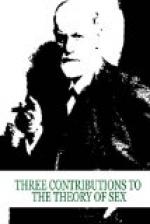But this ego-libido becomes conveniently accessible to psychoanalytic study only when the psychic energy is employed on sexual objects, that is when it becomes object libido. Then we see it as it concentrates and fixes itself on objects, or as it leaves those objects and passes over to others from which positions it directs the individual’s sexual activity, that is, it leads to partial and temporary extinction of the libido. Psychoanalysis of the so-called transference neuroses (hysteria and compulsion neurosis) offers us here a reliable insight.
Concerning the fates of the object libido we also state that it is withdrawn from the object, that it is preserved floating in special states of tension and is finally taken back into the ego, so that it again becomes ego-libido. In contradistinction to the object-libido we also call the ego-libido narcissistic libido. From psychoanalysis we look over the boundary which we are not permitted to pass into the activity of the narcissistic libido and thus form an idea of the relations between the two. The narcissistic or ego-libido appears to us as the great reservoir from which the energy for the investment of the object is sent out and into which it is drawn back again, while the narcissistic libido investment of the ego appears to us as the realized primitive state in the first childhood, which only becomes hidden by the later emissions of the libido, and is retained at the bottom behind them.
The task of a theory of libido of neurotic and psychotic disturbances would have for its object to express in terms of the libido-economy all observed phenomena and disclosed processes. It is easy to divine that the greater significance would attach thereby to the destinies of the ego-libido, especially where it would be the question of explaining the deeper psychotic disturbances. The difficulty then lies in the fact that the means of our investigation, psychoanalysis, at present gives us definite information only concerning the transformation of the object-libido, but cannot distinguish without further study the ego-libido from the other effective energies in the ego.[3]
DIFFERENTIATION BETWEEN MAN AND WOMAN
It is known that the sharp differentiation of the male and female character originates at puberty, and it is the resulting difference which, more than any other factor, decisively influences the later development of personality. To be sure, the male and female dispositions are easily recognizable even in infantile life; thus the development of sexual inhibitions (shame, loathing, sympathy, etc.) ensues earlier and with less resistance in the little girl than in the little boy. The tendency to sexual repression certainly seems much greater, and where partial impulses of sexuality are noticed they show a preference for the passive form. But, the autoerotic activity of the erogenous zones is the same in both sexes,




